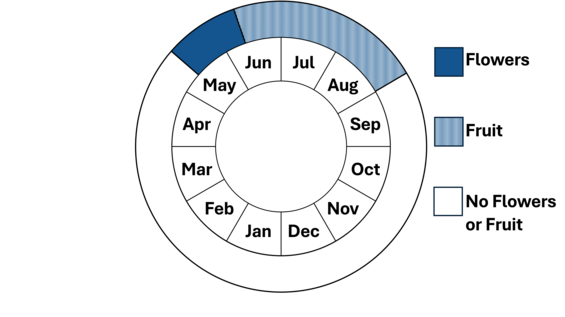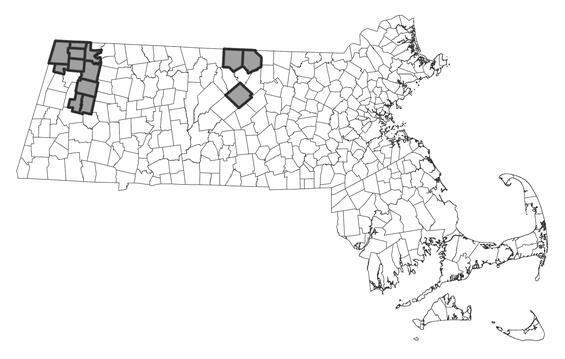- Scientific name: Amelanchier bartramiana (Tausch) M.Roem.
- Species of Greatest Conservation Need (MA State Wildlife Action Plan)
- Threatened (MA Endangered Species Act)
Description
Fruits and leaves of Bartram's shadbush. Photo credit: Peter Grima
Bartram’s shadbush (Amelanchier bartramiana) is a slender few-stemmed shrub approximately 0.5 - 2.5 m (1.5-8 ft) tall, occurring singly or forming open clumps. The branchlets are smooth and purplish gray in color. Its perfect flowers appear in the spring shortly after leaf out in May and unlike other shadbush species, occur singly or in clusters of only 2 or 3; petals are white and 6-12 mm (¼- ½ in) long, while the sepals are 4-5 mm (⅛- ⅕ in) long. The flowers are terminal and in the axils of the foliage leaves, with pedicels (stems) 10-25 mm (½ -1 in) long, growing slightly longer in fruit. The dull green leaves are sharply serrate almost to the leaf base, smooth, oblong-elliptic, and 2.5 to 5 cm (1-2 in) long, and are often tinged purplish-red when unfurling in spring. The petioles (leaf stems) are short, only 2-10 mm (1/8-3/8 in) long, often glabrous (hairless) but occasionally slightly silky. The elongated fruit (1-1.5 cm [0.4-0.6 in], 13 mm wide [½ in]) is a dark purple color, ripening in July and August.
Shadbushes can be difficult to identify, and two or three species are often found in the same vicinity. Bartram’s shadbush can be easily distinguished by its few flowers per cluster (only one to four) and the leaf shape that is tapered to each end, neither cordate nor rounded-elliptic at the base. Leaf tips are more tapered than in our other shadbushes. The leaves are more than twice as long as wide and the summit of its ovaries are hairy.
Bartram's shadbush flower. Photo credit: Peter Grima
Life cycle and behavior

Bartram’s shadbush is a multi-stemmed shrub, sometimes growing in dense stands with many ramets. Its leaf out occurs in early May; the young leaves may have a reddish tinge. The bright white, star-shaped flowers follow soon after in mid-May. This species is self-incompatible and needs others in its species nearby to set fruit. It occasionally hybridizes with smooth shadbush (Amelanchier laevis). It is identifiable by the distinct shape of its leaves as well as having clusters of only 1 to 4 flowers or fruits in a cluster.
Population status
Bartram’s shadbush is considered threatened in Massachusetts. In the past 25 years (2000 to 2025), sixteen occurrences have been verified; six other historical occurrences were recorded prior to that time. Three of the current observations are newly discovered populations in the past five years. All occurrences are found only in northern Berkshire and northern Worcester counties. Most of the populations in Massachusetts are small and consist of scattered plants. Only 3 populations have 100 or more ramets.
Distribution and abundance
Bartram’s shadbush ranges from Labrador, west to the Thunder Bay District of Ontario, and south to northern Massachusetts, northern Pennsylvania, northern Michigan, and northern Minnesota.

Distribution in Massachusetts
1999-2024
Based on records in the Natural Heritage Database
Habitat
Bartram’s shadbush is a boreal species of acid soils, found in bog edges, damp thickets, stream banks, open or swampy woods, wet, forested road edges or right of ways, and rugged mountainous terrain and open or semi-open habitats of summits. Often found within a matrix of spruce-fir or northern hardwood dominated forest, which in the mountains may be krummholz (forest dwarfed by extremely cold and windy conditions). Co-occurring species include balsam fir (Abies balsamea), yellow birch (Betula alleghaniensis), red maple (Acer rubrum), red spruce (Picea rubra), mountain-ashes (Sorbus americana and S. decora), highbush blueberry (Vaccinium corymbosum), and mountain holly (Ilex mucronata). This species mostly occurs in high-quality, unfragmented blocks of land.
Healthy habitats are vital for supporting native wildlife and plants. Explore habitats and learn about conservation and restoration in Massachusetts.
Photo credit: Peter Grima
Threats
Bartram’s shadbush occurs in areas with low disturbance, often in or near wetlands. Changes in land management and development near the species threaten its survival. In the past, it was impacted by clearing of mountain summits. The fact that Bartram’s shadbush is near the southern limit of its range in Massachusetts is a contributing factor to its rarity in the state. It occurs in areas that have cooler temperatures and is likely to be negatively impacted by higher temperatures predicted with climate change (Staudinger et al. 2024). As this species needs other individuals to cross-pollinate and form seed, if the populations get too small, they will not survive.
Conservation
Survey and monitoring
Regular survey of rare species is always needed to determine how the plants are doing, and whether the populations are expanding or decreasing. A population of this species can be widely scattered, so monitoring it and getting an accurate number of individuals in the population can be challenging.
Management
Avoiding changes to the hydrology and tree cutting in the vicinity of this species will help it survive.
References
Campbell, C.S. C.W. Greene and S.E. Bergquist. 1987. Apomixis and sexuality in three species of Amelanchier, Shadbush (Rosaceae, Maloideae). Amer. J. Botany 74(3):321-328.
Gleason, Henry A., and Arthur Cronquist. Manual of Vascular Plants of Northeastern United States and Adjacent Canada, Second Edition. Bronx, NY: The New York Botanical Garden, 1991.
Haines, Arthur. Flora Novae Angliae. New England Wild Flower Society, Yale University Press, New Haven, CT. 2011.
Knowlton, C.H. 1924. Flowering dates for Amelanchier bartramiana. Rhodora 26:178-179.
NatureServe. 2025. NatureServe Network Biodiversity Location Data accessed through NatureServe Explorer [web application]. NatureServe, Arlington, Virginia. Available https://explorer.natureserve.org/. Accessed: 2/7/2025.
POWO (2025). "Plants of the World Online. Facilitated by the Royal Botanic Gardens, Kew. Published on the Internet; https://powo.science.kew.org/ Retrieved 06 February 2025."
Soper, J.H. and M.L. Heimburger. 1982. Shrubs of Ontario. Royal Ontario Museum, Toronto. pp. 416-417.
Staudinger, M.D., A.V. Karmalkar, K. Terwilliger, K. Burgio, A. Lubeck, H. Higgins, T. Rice, T.L. Morelli, A. D’Amato. A Regional Synthesis of Climate Data to Inform the 2025 State Wildlife Action Plans in the Northeast U.S. U.S. DOI Northeast Climate Adaptation Science Center Cooperator Report. 406 p. https://doi.org/10.21429/t352-9q86 2024
Wiegand, K.M. 1912. The genus Amelanchier in eastern North America. Rhodora 14(163):117-161.
Contact
| Date published: | March 6, 2025 |
|---|